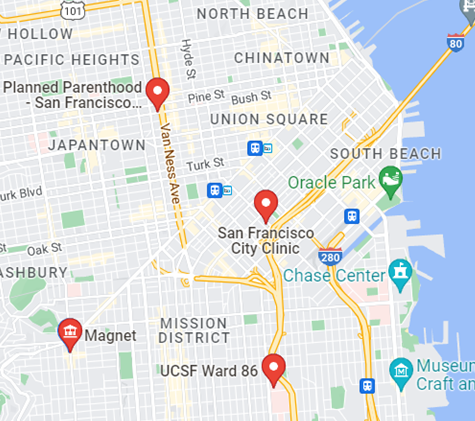Strengthening the United States Response to Resistant Gonorrhea (SURRG) began in 2016 with three goals:
California-San Francisco Strengthening the US Response to Resistant Gonorrhea Project (CA-SF SURRG) began in May 2017. The project is being conducted in collaboration with the San Francisco Public Health Department (SFDPH) and San Francisco Public Health Lab (SFPHL).
SURRG Partnerships
Currently, SURRG is partnering with one STD clinic and three non-STD (community) clinics:
Future goals are expanding the project to include more STD and non-STD clinics across the state. All providers in California can test for gonorrhea and connect to the CDPH through their local public health department if they have a suspected treatment failure.
The San Francisco Public Health Lab can conduct GC antimicrobial susceptibility testing through Etest. This enables rapid local detection of susceptibility and resistance among gonorrhea cultures. SURRG is working to establish local Etest capacity throughout California to enhance our ability to detect and prevent the spread of antibiotic-resistant gonorrhea.
SURRG Health Equity
In order to contain the potential threat of a widespread antibiotic-resistant gonorrhea outbreak, we need to work together with local health jurisdictions and clinics to provide culturally competent and trauma-informed testing and care. We are working to ensure clinics that serve populations who have been historically disadvantaged and acquiring gonorrhea at higher rates have support from SURRG. This will enable them to handle potential antibiotic-resistant gonorrhea outbreaks, increase their ability to perform cultures, and obtain access to antimicrobial susceptibility testing.
Established in 1986, the Gonococcal Isolate Surveillance Project (GISP) monitors US antibiotic resistance trends in gonorrhea. Through the collaborative effort of selected STD clinics and their local laboratories, regional laboratories, and CDC, GISP’s collected data helps ensure patients with gonorrhea receive the right antibiotic treatment. Participating regional laboratories test the specimens for resistance to the antibiotic drugs azithromycin, cefixime, ceftriaxone, ciprofloxacin, gentamicin, penicillin, and tetracycline (CDC, 2021). California has participating sentinel sites in Los Angeles, Orange County, San Diego, and San Francisco.
The STD Surveillance Network (SSuN) is a collaborative network of state, county, and/or city health departments funded by the CDC to conduct sentinel and enhanced STD surveillance activities. The purpose is to improve the capacity of national, state, and local STD programs to detect, monitor, and respond to trends in STDs through the enhanced collection, reporting, analysis, visualization, and interpretation of disease information. The California Department of Public Health has been a collaborator with the STD Surveillance Network (SSuN) since 2009.